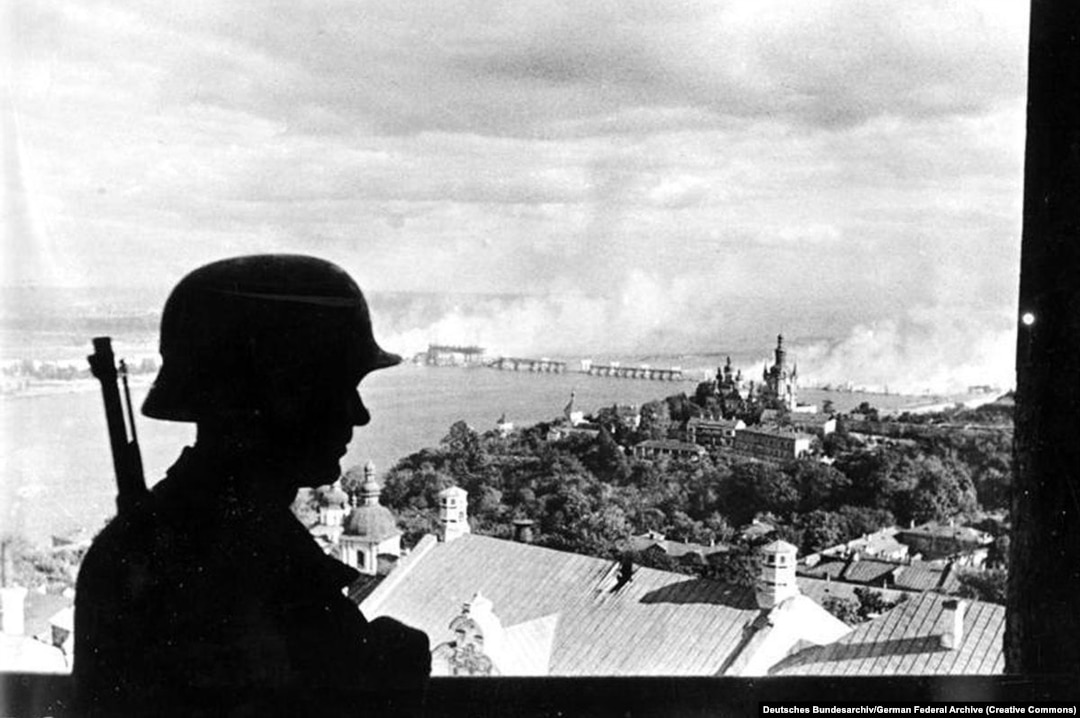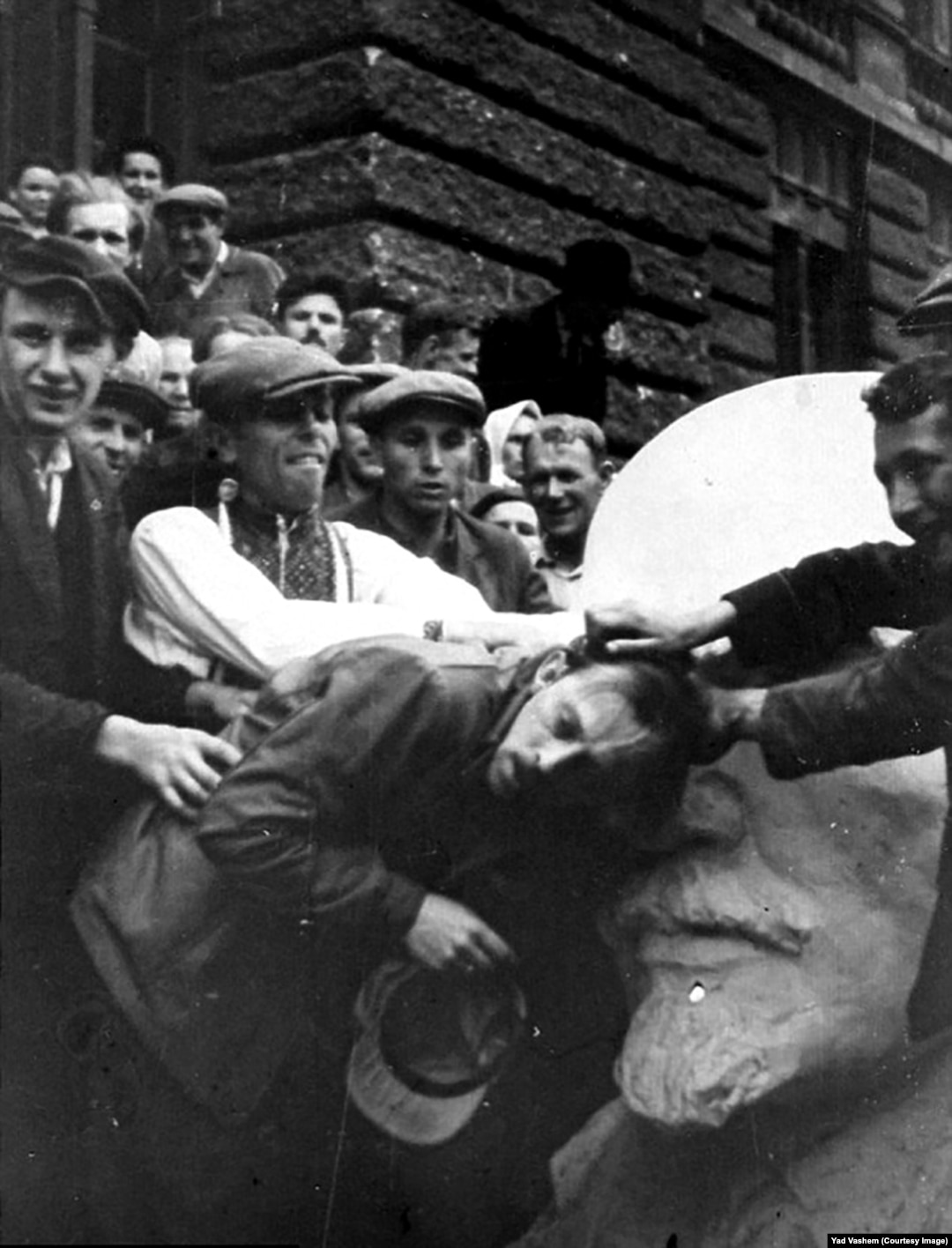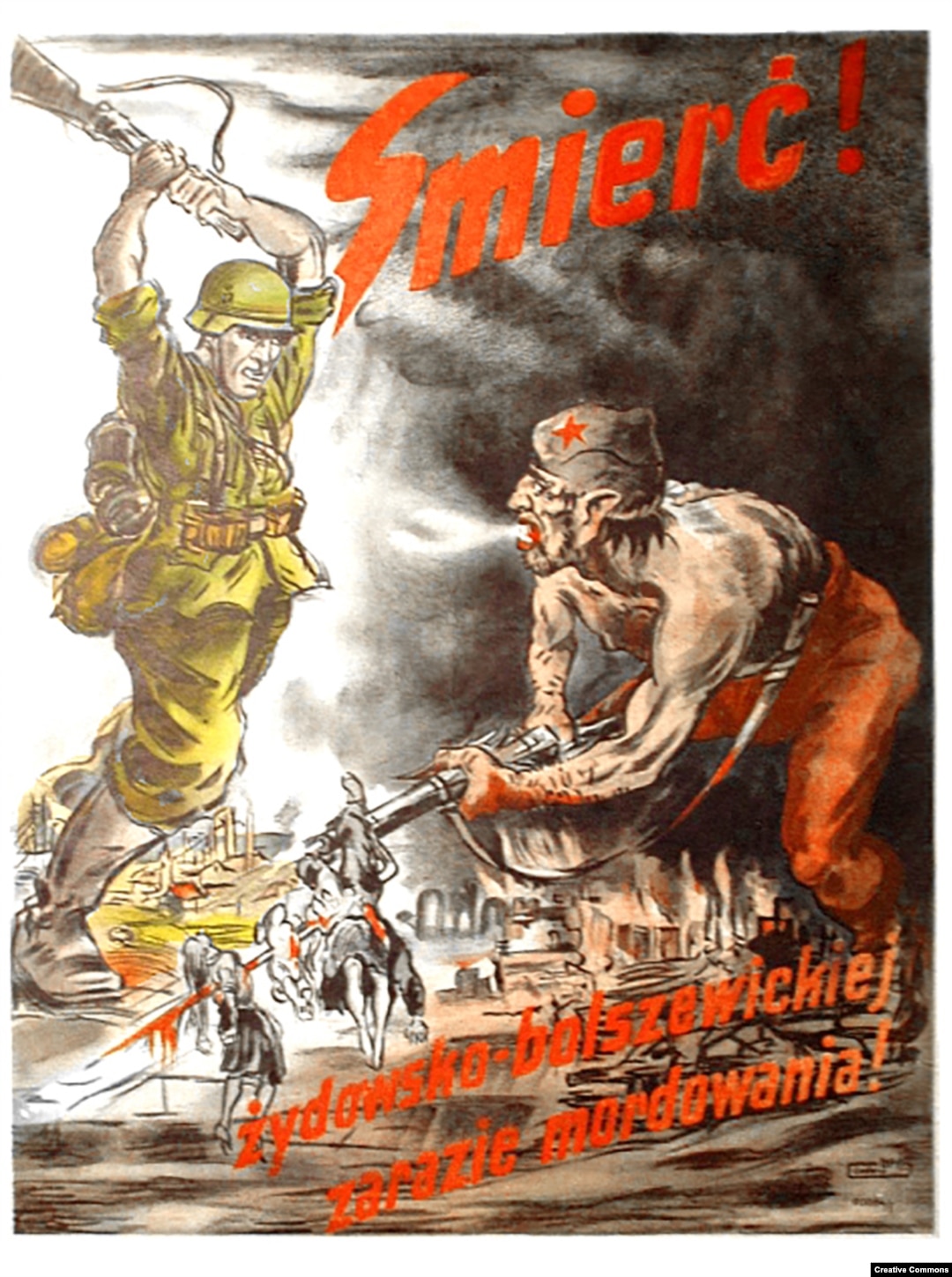'Still Much To Say': Remembering The Massacre At Babyn Yar

A Nazi sentry in Kyiv on September 19, 1941. In June of that year, after two years of neutrality between Germany and the Soviet Union, Nazi forces launched a surprise attack on the U.S.S.R. Within weeks, Nazi forces had overrun eastern Poland and other Soviet-occupied territories, as well as much of the Ukrainian S.S.R. and other Soviet republics.

A Jewish man in western Ukraine being attacked by a mob next to a bust of Lenin. After occupying Nazi forces opened Soviet secret police prisons, atrocities carried out under Stalin were laid bare and exploited by Nazi propagandists, who fueled anti-Semitism by highlighting the Jewish backgrounds of some early Soviet leaders.

A Nazi propaganda poster declaring "death to the Jewish-Bolshevik pestilence of murdering." As well as executions at the hands of the Soviet secret police, millions of Ukrainians had died under Stalin in a man-made famine. Nazi propaganda linking Jews with Soviet rule fed the beliefs of some elements of the Ukrainian nationalist movement in a region with a history of anti-Semitic violence.
With the active encouragement of the Nazis, horror is unleashed on the Jewish population of the Soviet Ukraine and territories that had been occupied by Soviet forces. This woman is fleeing from a mob in Lviv, a Polish city overtaken by Soviet and then Nazi forces that is today part of western Ukraine -- in June or July 1941. Thousands of Jews were tormented and murdered by mobs of locals during a series of pogroms in Central and Eastern Europe.
In Kyiv, time bombs left by retreating Soviet forces exploded, killing several Nazis. A survivor of Babyn Yar recalled that "of course, the Jews were blamed for it. [We] were to blame for everything." On September 26, just a week after capturing Kyiv, the Nazis issued this order, using the derogatory term "yids" for Jews.
"All yids of the city of Kyiv and its vicinity must appear on Monday, September 29, by 8 o'clock in the morning at the corner of Melnikova and Dorohozhytska streets (near the Viiskove cemetery). Bring documents, money and valuables, and also warm clothing, linens, etc. Any yids who do not follow this order and are found elsewhere will be shot."
As demanded by the orders published in Ukrainian, Russian, and German, some 30,000 Jews from Kyiv and the vicinity arrived on September 29 at various meeting points in the city center. They were then marched northwest to the edge of town to a large ravine known as Babyn Yar or "Old Woman's Ravine." Some of the marchers, nearing a railway yard alongside Babyn Yar, believed they were about to be deported to Palestine.
After two years of neutral relations between Nazi Germany and the U.S.S.R., and with information tightly controlled by Soviet media, the Jews of Kyiv have little understanding of the danger they are in.
One German soldier recalled that the Jews of the U.S.S.R. were ''shockingly ill-informed about our attitude toward them.''
Some of the child victims of the massacre at Babyn Yar. Left to right: Anna Glinberg, Malvina and Polina Babat, and Velvele Valentin Pinkert. One survivor who recalled the events decades later said some locals who had sought to bid farewell to their Jewish neighbors before their "deportation" were also shot dead once they reached the ravine. "It was nothing for [the Nazis] to kill people."
Soviet prisoners of war in the ravine after the massacre. Babyn Yar continued to be used by the Nazis as a killing site for Soviet POWs, Roma, and other "undesirables."
For more than three decades after the war, the events at Babyn Yar receive little official recognition, although in the 1960s Jewish activists began gathering without permission at the site to keep the memory of what happened there alive. In 1976, this memorial commemorating all victims of the Nazi regime at Babyn Yar was erected, without making specific mention of the Jewish victims. The central figure of the monument is a Soviet soldier.
A celebration in Kyiv on May 9, 1985, marking the anniversary of victory over the Nazis. For the authorities of Soviet Ukraine, the events at Babyn Yar were seen through the prism of wholesale Soviet suffering under the Nazis.
Fifty years after the massacre, after Ukraine gained independence from the U.S.S.R. in 1991, a separate memorial dedicated to the Jewish victims of the atrocity was unveiled on the site. A crowd of hundreds gathered for the unveiling of the menorah-shaped monument.
The menorah monument to Babyn Yar is located today in a quiet park dotted with strolling couples and friends riding bicycles under a canopy of trees.
"There are events, tragedies, the enormity of which make all words futile and of which silence tells incomparably more -- the awesome silence of thousands of people. Perhaps we, too, should keep silent and only meditate. But silence says a lot only when everything that could have been said has already been said. If there is still much to say, or if nothing has yet been said, then silence becomes a partner to falsehood and enslavement. We must, therefore, speak -- and to speak whenever we can, taking advantage of all opportunities, for they come so infrequently."
-- Address made at Babyn Yar by Ukrainian writer Ivan Dzuiba in 1966

